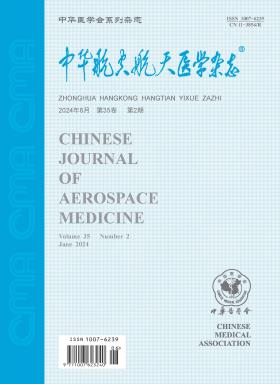雪莲培养细胞提取物抗急性低压缺氧的机制研究
引用次数: 0
摘要
目的探讨雪莲细胞提取物对急性低压缺氧的抵抗作用及其机制。方法36只Wistar大鼠按随机数字表法分为空白对照组、阴性对照组和天山雪莲培养细胞提取物组。将山雪莲培养细胞提取物以500 mg/kg的剂量灌胃给山雪莲培养细胞提取物组大鼠14 d,其余2组大鼠灌胃蒸馏水。除空白对照组外,其余各组大鼠均暴露于模拟海拔8 000 m的环境中,经14 d的输注后急性低压缺氧。然后处死各组大鼠,取血清和脑组织标本。检测脑组织和血清中谷氨酸(GLU)、乳酸(LD)、乳酸脱氢酶(LDH)、丙二醛(MDA)、总抗氧化能力(T-AOC)、谷胱甘肽过氧化物酶(GSH-PX)等生化指标的变化。结果与空白对照组相比,阴性对照组血清和脑组织中GLU、NO、LD、LDH、MDA均显著升高(P<0.01), Na+ -K+ -ATPase、Ca2+ -Mg2+ -ATPase、T-AOC、SOD、GSH-PX均显著降低(P<0.01)。雪莲细胞提取物组GLU、NO、LD、LDH和MDA极显著低于阴性对照组(P<0.01),而Na+ -K+ -ATPase、Ca2+ -Mg2+ -ATPase、T-AOC、SOD和GSH-PX极显著高于阴性对照组(P<0.01)。结论在模拟8 000 m缺氧暴露条件下,雪莲培养细胞提取物能有效清除或抑制过量氧自由基的产生,并可能阻止谷氨酸和乳酸在大鼠脑组织和血清中的积累。通过保护细胞膜上Na+ -K+ -ATPase和Ca2+ -Mg2+ -ATPase的功能,防止由此引起的能量代谢紊乱引起的毒性反应,减轻细胞水肿,保护脑组织和细胞的完整性和功能,有效缓解急性低压缺氧。关键词:大鼠;Wistar;细胞培养;细胞提取物;缺氧;光学有总苞的本文章由计算机程序翻译,如有差异,请以英文原文为准。
Mechanism research for the resistant effects of Saussurea involucrate cultured cell extracts on acute hypobaric hypoxia
Objective
To investigate the resistance to acute hypobaric hypoxia of Saussurea involucrata cultured cell extracts and the underlying mechanism.
Methods
Thirty-six Wistar rats were averagely divided into blank control group, negative control group and Saussurea involucrate cultured cell extracts group according to random number table. The Saussurea involucrate cultured cell extracts were infused to the rats of Saussurea involucrate cultured cell extracts group with the dose of 500 mg/kg for 14 d while the distilled water was fed to other 2 groups in the period. Except blank control group, the rats of other groups were exposed in simulative 8 000 m altitude experiencing acute hypobaric hypoxia after 14 d infusion. Then the rats of all groups were killed and sampled blood serum and brain tissue. The changes of various biochemical factors in brain tissue and blood serum, such as glutamic acid (GLU), lactic acid (LD), lactate dehydrogenase (LDH), malondialdehyde (MDA), total antioxidant capacity (T-AOC) and glutathion peroxidase (GSH-PX) were tested.
Results
Comparing with those of blank control group, the GLU, NO, LD, LDH and MDA in blood serum and brain tissue of negative control group were significantly increased (P<0.01), and Na+ -K+ -ATPase, Ca2+ -Mg2+ -ATPase, T-AOC, SOD and GSH-PX were significantly decreased (P<0.01). The GLU, NO, LD, LDH and MDA of Saussurea involucrate cultured cell extracts group were significantly lower than those of negative control group (P<0.01) but with significantly higher Na+ -K+ -ATPase, Ca2+ -Mg2+ -ATPase, T-AOC, SOD and GSH-PX (P<0.01).
Conclusions
For simulated 8 000 m hypoxia exposure, Saussurea involucrata cultured cell extracts can effectively remove or inhibit the generation of excessive oxygen free radicals and may prevent glutamic acid and lactic acid from accumulating in rat brain tissue and blood serum. By protecting the function of Na+ -K+ -ATPase and Ca2+ -Mg2+ -ATPase on cell membrane and preventing the consequent toxic reaction induced by energy metabolism disorder, they can alleviate cell edema, protect the integrity and function of brain tissues and cells and effectively ease acute hypobaric hypoxia.
Key words:
Rats, Wistar; Cells, cultured; Cell extracts; Anoxia; Saussurea involucrate
求助全文
通过发布文献求助,成功后即可免费获取论文全文。
去求助
来源期刊

中华航空航天医学杂志
航空航天医学
自引率
0.00%
发文量
2962
期刊介绍:
The aim of Chinese Journal of Aerospace Medicine is to combine theory and practice, improve and popularize, actively advocate a hundred flowers bloom and a hundred schools of thought contend, advocate seeking truth from facts, promote the development of the related disciplines of aerospace medicine and human efficiency, and promote the exchange and penetration of aerospace medicine and human efficiency with other biomedical and engineering specialties.
Topics of interest for Chinese Journal of Aerospace Medicine include:
-The content of the journal belongs to the discipline of special medicine and military medicine, with the characteristics of multidisciplinary synthesis and cross-penetration, and mainly reflected in the aerospace industry, aerospace flight safety and efficiency, as well as the synthesis of special medicine, preventive medicine, environmental medicine, psychology, etc.
-Military aeromedicine (Air Force, Navy and Army aeromedicine) and civil aeromedicine, with a balance of aerospace medicine are the strengths of the journal.
-The change in aerospace medicine from a focus on promoting physiological compensatory adaptations to enhancing human performance under extreme environmental conditions is what the journal is helping to promote.
-The expansion of manuscripts in high altitude medicine is also a special emphasis of the journal.
 求助内容:
求助内容: 应助结果提醒方式:
应助结果提醒方式:


